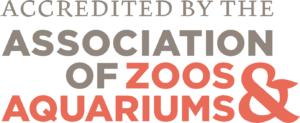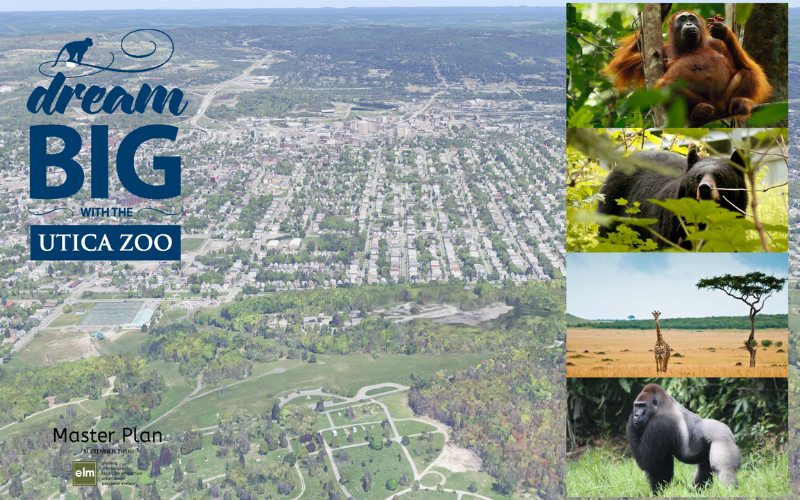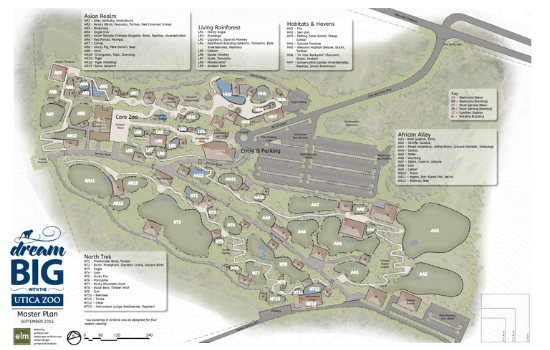History of the Utica Zoo
The Utica Zoo has served the region for over 100 years. Located in Roscoe-Conkling Park, the zoo is part of a recreational complex made possible by the donation of land from Thomas R. Proctor in 1909. He had a dream that a park could do as much for South Utica as Central Park was doing for New York City. He hired a famous landscape architect, Frederick Law Olmstead Jr., whose father had designed Central Park, to plan the roads and scenic walkways in Roscoe Conkling Park. The Zoo has grown from its small beginnings with three fallow deer in 1914, to its present collection of over 99 species of animals. Of the 67 acres of land set aside for the zoo’s use, 35 are presently developed.
The Zoo property is owned by the City of Utica and until 1964 was operated by the Parks Department. In order to ensure the Utica Zoo’s continued existence, the Utica Zoological Society assumed full management of the zoo in 1964. The first professional zoo director was hired in 1966. One year later, Marlin Perkins officiated at the opening of the Children’ s Zoo. The society was chartered as an educational institution by the New York State Educational Department in 1968. In 1973, the education department was established with the appointment of a curator to carry out its programs.
The first building (completed in 1920) is currently named the Wildlife Building and houses the administrative offices, auditorium, reptile exhibits, and the zoo’ s kitchen. In 1981, the Animal Care Center was added to the Wildlife Building for the quarantine and veterinary facilities. The first building made exclusively for animal use was completed in 1927 and still houses the primate collection. Other major exhibits include the Lion exhibit, California sea lion exhibit (finished in 1986), and the Outdoor White-Handed Gibbon Living Rainforest exhibit (opened in 2018). A new Striped Hyena and Mexican Spider Monkey exhibit were completed in the spring of 2020.
Utica Zoo is a regional facility and a sparkling gem for the Mohawk Valley. The zoo receives annual support from Oneida County, an unrestricted grant from the Sinnott Family Fund at Fidelity Charitable, and an annual operating grant from the Natural Heritage Trust (a state agency). The remainder of the budget is raised by the Society. Admission fees, society membership, special events such as Wine in the Wilderness, Brewfest, and Spooktacular, the gift shop, the Animal Adoption program, animal encounters, animal feed sales, stroller rentals, pavilion rentals, and donations complete the operating budget income. Major capital improvements are funded through specific fund drives, major grants, and other contributions and sponsorships.
Interested in the Utica Zoo Historical Archive?
Thanks to the Utica College Center for Historical Research, a large amount of our newsletters, news articles, and photos from the 1960s until now have been digitally archived. To look through them, follow the link below:
Mission
Utica Zoo creates unique experiences and promotes public appreciation of wildlife through education, conservation, and recreation.
Vision
Utica Zoo will be a premier destination for visitor experience while providing excellence in animal care.
Accredited by the Association of Zoos & Aquariums
The Association of Zoos and Aquariums is an independent accrediting organization representing the best
aquariums and zoos in the United States and the world, assuring when you visit an AZA-accredited facility, it meets the highest standards. Less than 10 percent of the 2,800 wildlife exhibitors licensed by the United States Department of Agriculture under the Animal Welfare Act meet the more comprehensive standards of AZA accreditation.

The highly trained professionals at AZA-accredited zoos and aquariums are the leading experts in animal care and welfare, providing excellent care for more than 800,000 animals. This logo is your assurance that you are supporting an organization dedicated to providing excellent care for animals, a great experience for you and your family, and a better future for all living things.
The Utica Zoo received accreditation in 2018, and actively maintains that status.
Master Plan

Utica Zoo released their new master plan on September 27, 2016 at a private party sponsored by First Source Federal Credit Union. The theme of the night was “Dream BIG with the Utica Zoo.” Invitees got the first look at what is planned for the next 20 years at the Utica Zoo.
It is the zoo’s first comprehensive master plan since 1990. Utica Zoo hired the company ELM Environments out of Seattle, WA to help create the document. ELM Environments used a concept called “return on exhibit” (ROE) to analyze every part of the current zoo, and future expansions. Utica Zoo has 80 acres of land, 45 of which are available to expand. Return on exhibit looks at the conservation status of a species (endangered, threatened, stable etc.), the educational aspects of the animal, visitor experience, cost to feed the animals, and cost to build or maintain the exhibits. With ROE, the Utica Zoo and ELM Environments have determined what animals and exhibits to keep, what exhibits to upgrade, and what changes and additions need to be made to the facility as a whole.
Utica Zoo’s Master Plan is broken down into 3, 5, 10, and 20 year goals. Highlights of the plan include animal additions like giraffe, black bear, otters, tigers, and orangutan. Visitor favorites like the red pandas will also receive new exhibits.
“Signature animals like giraffe and otter are extremely exciting, but we are also looking forward to other important upgrades like new parking lots, a bus loop, new layout for visitor pathways, and additional restrooms and visitor services,” said Executive Director, Andria Heath. Heath continued, “We have a wonderful history of connecting children and families with nature, and it is our job to ensure that future generations have the same opportunity to create life-long memories.”
The Utica Zoo master plan is considered a living document, and changes can be made to it when an exhibit is built faster than planned, funds are received, or different species are desired. The Zoo looks to private and public donors to help build and maintain exhibits. If you, or your business are interested in making a part of the master plan come to life, you can contact Executive Director, Andria Heath at: Office (315) 738-0472 ext. 41. Email a.heath@uticazoo.org.
Utica Zoo’s “Dream BIG” Master Plan unveiling event was sponsored by First Source Federal Credit Union.


